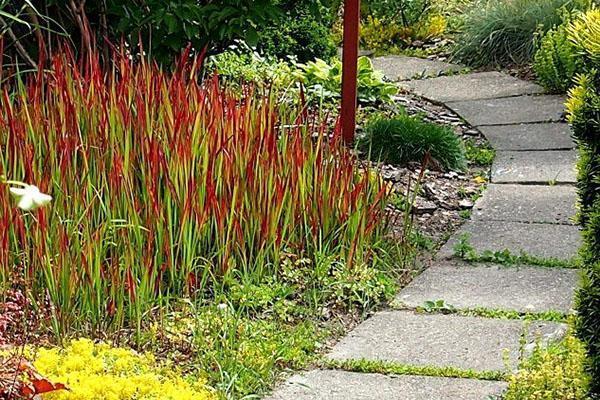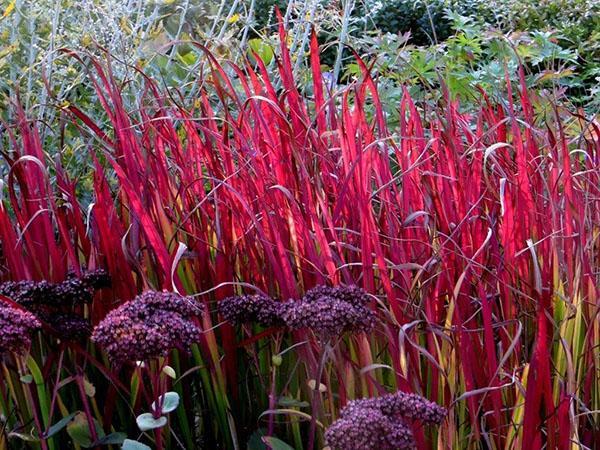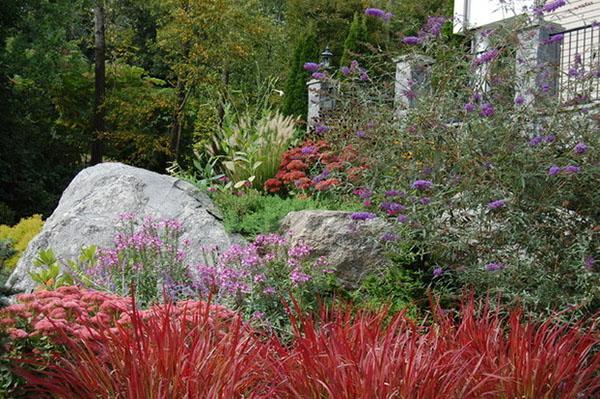The most beautiful cereals - cylindrical impera
 More recently, our grandmothers could not think of planting ornamental grass, albeit beautiful, in a flower garden, it was believed that it only interferes with the growth of useful plants. But times are changing, and decorative grains have taken their rightful place in our gardens. The primacy among them in beauty, no doubt, is occupied by the emperor. An unpretentious perennial cereal, with its bright crimson leaves, will decorate any garden plot.
More recently, our grandmothers could not think of planting ornamental grass, albeit beautiful, in a flower garden, it was believed that it only interferes with the growth of useful plants. But times are changing, and decorative grains have taken their rightful place in our gardens. The primacy among them in beauty, no doubt, is occupied by the emperor. An unpretentious perennial cereal, with its bright crimson leaves, will decorate any garden plot.
general description

In the wild, the plant grows in Southeast Asia, in the Caucasus, she loves sandy soils and places near rivers. In culture, in gardens and parks, the Imperata Red Baron variety is widespread. It grows up to forty centimeters in height, although its young leaves can be bright green, but as they grow, they become red in color, at the end of summer they acquire a completely bloody color.
Planting and caring for the Emperor Cylindrical Red Baron
 If there is already a collection of cereals on the personal plot, and not only of the traditional green color, but also of a yellow hue, then bright red leaves will add the necessary accent to your landscape design.
If there is already a collection of cereals on the personal plot, and not only of the traditional green color, but also of a yellow hue, then bright red leaves will add the necessary accent to your landscape design.
For rare cereals, planting materials are preferable to purchase in trusted stores, since in this case you need to be absolutely sure that you have purchased a high-quality varietal plant.
True, the Emperor Red Baron may well be looked after by some experienced florists. This cereal hibernates perfectly in a cold climate, and there are almost no problems with it.
Landing
In order for your grass to retain its traditional decorative effect for this variety, it is extremely important to choose a good place for planting ideally. The cereal withstands light partial shade, however, it becomes bright red only in a sunny and open flower bed. Planting and caring for the Red Baron cylindrical imperial does not present visible problems, but it grows rather slowly. In the third or fourth year of life, the plant grows tall and acquires a characteristic reddish tint.
The soil must be drained, the cereal does not like places with stagnant moisture. If there is insufficient drainage, the plant may rot its roots. However, the rest of the landing is carried out in a simple traditional way:
- Large holes, they should be made twice as large as the root system of the seedling.
- Put compost at the bottom of the pit.
- After the compost, you need to put a mineral complex fertilizer.
After the preparatory work, the young sapling of the Emperor Red Baron must be placed in a hole, covered with earth, watered and tamped. After that, the place around the planting is mulched with a small layer of peat (about three centimeters).
Care
 The plant does not like moisture too much, however, on hot summer days it is better to water it abundantly. Also intense watering needed in the spring when young shoots are formed.Although the emperor cylindrical does not tolerate stagnant water, it prefers intensive irrigation.
The plant does not like moisture too much, however, on hot summer days it is better to water it abundantly. Also intense watering needed in the spring when young shoots are formed.Although the emperor cylindrical does not tolerate stagnant water, it prefers intensive irrigation.
In the fall, the plant should be pruned, leaving pieces of leaves about ten centimeters from the ground. Before the onset of cold weather, you need to additionally mulch your decorative cereal. If green shoots appear on the plant in the fall or at the end of summer, they should be cut out immediately, preventing them from growing too much, otherwise the appearance of the bush will be hopelessly spoiled.
When you start replanting the cylindrical imperato, you need to make sure that the ground is constantly wet, but not very wet. This plant does not take root well in new places, if there is little moisture, it will die.
Reproduction is carried out by simple division of an adult bush. The process of dividing itself is carried out at a time when the bushes have grown profusely, and in the middle they began to grow slightly bald. In doing so, consider the following:
- It is best to propagate the cereal in the spring.
- The plant should be dug up by the root.
- We must try not to damage the root
- You can neatly split part of the excavated plant again.
During the summer and spring, the plant needs to be fed two or three times. Loves imperator cylindrical Red Baron very much mineral fertilizers... However, if the soil in your garden is fertile, then the plant may not be fertilized at all. It is especially pleasant that the red cereal is not afraid of pests or diseases.
You do not need to force this plant to bloom with all your might. The Impera grass is not in the wild, and almost never blooms in the cultural environment. The plant already has a great decorative value because of its bright foliage.
In landscape design
 In late autumn, when all garden plants have faded, cereals continue to delight with brightness of colors, attractive appearance, and therefore at this time of year they play a dominant role in the garden. But this is not the only reason why our flower growers are so fond of the cylindrical imperate Red Baron: the geometric shape and picturesqueness of the leaves create a special accent on the decorative flower bed.
In late autumn, when all garden plants have faded, cereals continue to delight with brightness of colors, attractive appearance, and therefore at this time of year they play a dominant role in the garden. But this is not the only reason why our flower growers are so fond of the cylindrical imperate Red Baron: the geometric shape and picturesqueness of the leaves create a special accent on the decorative flower bed.
The plant is very suitable for a small garden. Great background for imperates - green conifers and bushes with large leaves. The red cereal looks great next to the creeping juniper. You can grow this plant in a container, which is brought into the veranda or winter garden for the winter. In the fall, the impera grass in a pot looks extraordinary against the background of falling asleep nature.
 This type of cereal is almost always present in the classic Japanese garden. The plant looks great on an emerald lawn in the idea of a single planting. The emperor can be planted in the middle of a flower bed, making it the center of the original composition.
This type of cereal is almost always present in the classic Japanese garden. The plant looks great on an emerald lawn in the idea of a single planting. The emperor can be planted in the middle of a flower bed, making it the center of the original composition.
 If you have not yet figured out how to decorate the small shore of the pond in the garden in an original way, then the ideal option is the planting of the Red Baron emperor, especially since caring for it is simple. The bright red leaves of this plant will turn your pond into a fairy tale.
If you have not yet figured out how to decorate the small shore of the pond in the garden in an original way, then the ideal option is the planting of the Red Baron emperor, especially since caring for it is simple. The bright red leaves of this plant will turn your pond into a fairy tale.
So, if you are a novice gardener and want to immediately make your place for relaxation spectacular, then plant an imperata. The plant never gets sick, there is no trouble with it, but it looks incomparable, delighting with bright red leaves until the very cold.